Preveza,Epirus 作者: 来源: 发布时间:2021-07-13
I.Population and Area
Location within the region
Coordinates: 38°57′N 20°44′E
Country Greece
Administrative region Epirus
Regional unit Preveza
Area
• Municipality 380.5 km2 (146.9 sq mi)
• Municipal unit 66.8 km2 (25.8 sq mi)
Elevation 8 m (26 ft)
Population (2011)
• Municipality 31,733
• Municipality density 83/km2 (220/sq mi)
• Municipal unit 22,853
• Municipal unit density 340/km2 (890/sq mi)
Demonym(s) Prevezian
Community
• Population 20,795 (2011)
Time zone UTC+2 (EET)
• Summer (DST) UTC+3 (EEST)
Postal code 481 00
Area code(s) 26820
Vehicle registration ΡΖ
Preveza is a city in the region of Epirus, northwestern Greece, located at the mouth of the Ambracian Gulf. It is the capital of the regional unit of Preveza, which is part of the region of Epirus. The Aktio-Preveza Immersed Tunnel – the first and so far only undersea tunnel in Greece – was completed in 2002 and connects Preveza to Aktio in western Acarnania in Aetolia-Acarnania. The ruins of the ancient city of Nicopolis lie 7 kilometres (4 miles) north of the city.
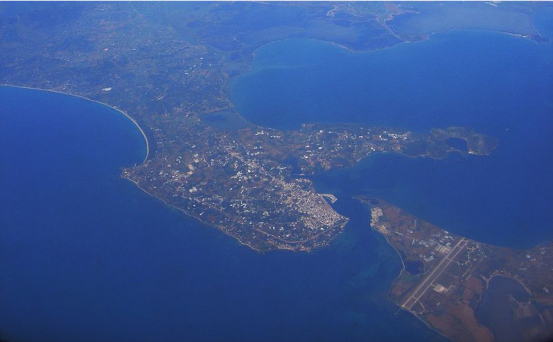
II.Natural Geography (environment and resources)
Transport
Preveza is linked by road to Igoumenitsa and other coastal settlements through the E55 national road, and is also linked with other cities in Epirus such as Ioannina and Arta. The Aktio-Preveza Undersea Tunnel links Preveza by road to Aetolia-Acarnania in Central Greece. Preveza also has a small commercial and passenger port and is served by the nearby Aktion National Airport, which also serves the island of Lefkada.
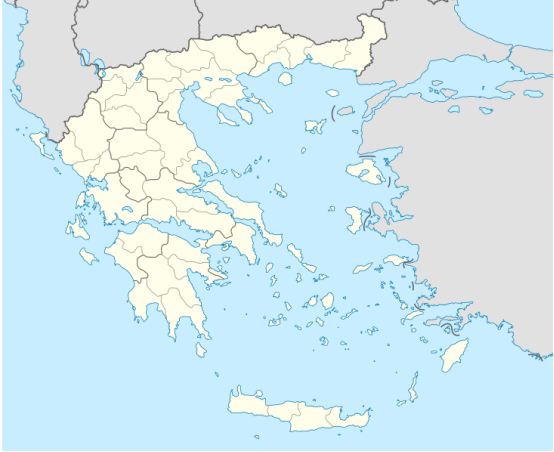
III.Economy
Preveza - Euro per inhabitant
12,400.00
in 2011
Preveza euro per inhabitant was at level of 12,400 in 2011, down from 13,500 previous year, this is a change of 8.15%.

Preveza - Purchasing Power Standard per inhabitant in percentage of the EU average
54.00
in 2011
Preveza purchasing power standard per inhabitant in percentage of the EU average was at level of 54 in 2011, down from 60 previous year, this is a change of 10.00%.
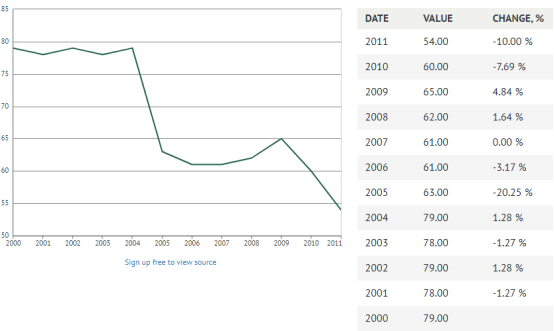
Preveza - Purchasing Power Standard per inhabitant
13,400.00
in 2011
Preveza purchasing power standard per inhabitant was at level of 13,400 in 2011, down from 14,700 previous year, this is a change of 8.84%.
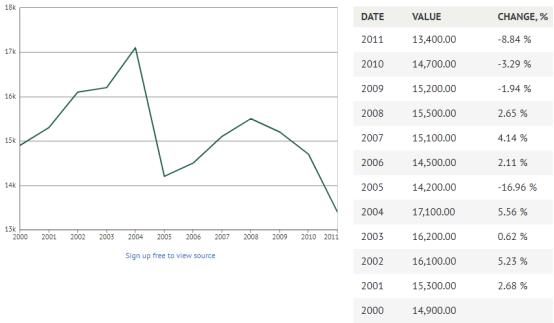
Reference: https://knoema.com/search?query=preveza%2C%20%20economy
IV.Industrial Characterisitics
Not applicable.
V.Attractions
Ancient Nicopolis area (Walls, Basilica of Alkisson, Basilica of Domitius, Roman Odeon, Nympheum, Roman Baths, Cemetery, Theatre, Augustus Monument, Roman Stadium, Roman Villa of Manius Antoninus etc.)
Nicopolis (Greek: Νικόπολις Nikópolis, "City of Victory") or Actia Nicopolis was the capital city of the Roman province of Epirus Vetus. It was located in the western part of the modern state of Greece. The city was founded in 29 BC by Caesar Augustus in commemoration of his victory in 31 BC over Antony and Cleopatra at the Battle of Actium nearby. It was soon made the major city of the wider region of Epirus region. Many impressive ruins of the ancient city may be visited today.
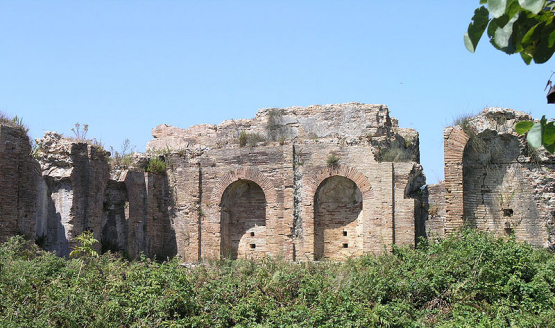
The Roman nymphaeum of Nicopolis
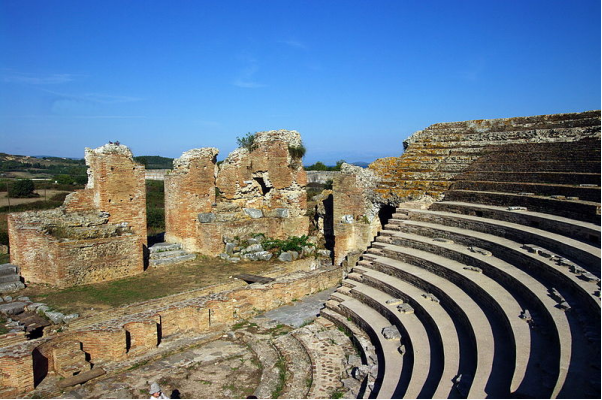
The ancient Odeon.
Ancient Cassope (400 BC), 25 km (16 mi) from Preveza
Kassope or Cassope (Ancient Greek: Κασσώπη - Kassōpē, also Κασσωπία - Kassōpia and Κασσιόπη - Kassiopē) was an ancient Greek city in Epirus.
Kassope occupies a magnificent and remote site on a high platform overlooking the sea, the Ambracian Gulf and the fertile lands to the south, and with the slopes of the Zalongo mountain to the north.
It is considered one of the best remaining examples of a city built on a rectilinear street grid of a Hippodamian plan in Greece.
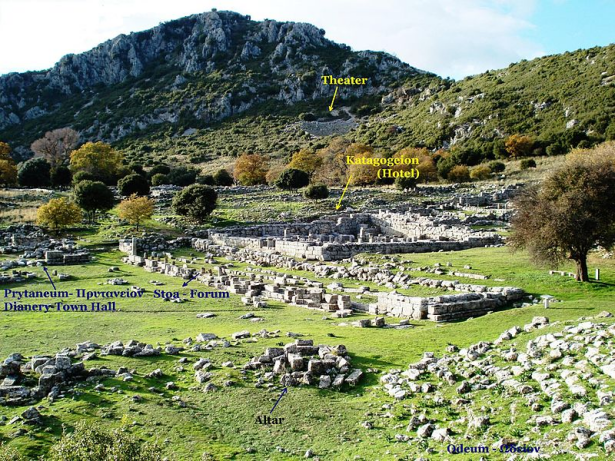
View of the site of Kassope
-- Ancient Trikastron citadel (700 – 300BC), 30 km (19 mi) from Preveza
-- Ancient Berenikea, Michalitsi village hills (270 BC).
-- Archaeological Museum of Nikopolis
-- St. Charalampos Church (1715–1793)
-- St. Varnavas Church
-- St. Abassos Church
-- Forest of Lekatsas, in Myrsini village
-- Fortress of Laskara, Ali Pasha period (1810)
-- Fortress of Pantocrator, Ali Pasha period (1810)
-- Fortress of Saint Andrew, Venetian (1701–1717) and Ottoman period (1810)
-- St. George's Castle, Preveza (1718)
-- Fortress of Reniassa (or Fortress of Despo) in Riza (1280)
-- St. Elias Church (1780)
-- Aktio-Preveza Undersea Tunnel, 2002
-- Kostas Karyotakis' statue and last residence
-- Madonna Church of Foreigners (Panagia ton Xenon) (1780)
-- Monolithi beach and Monolithi forest
-- National Bank of Greece building (1931)
-- Odysseus Androutsos' marble statue
-- Ottoman baths of Ali Pasha Tepelena
-- Seytan Pazar, traditional commercial street
-- Venetian clock tower of Preveza
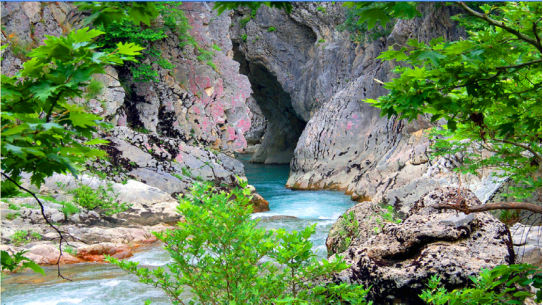
Canoeing in Acheron river
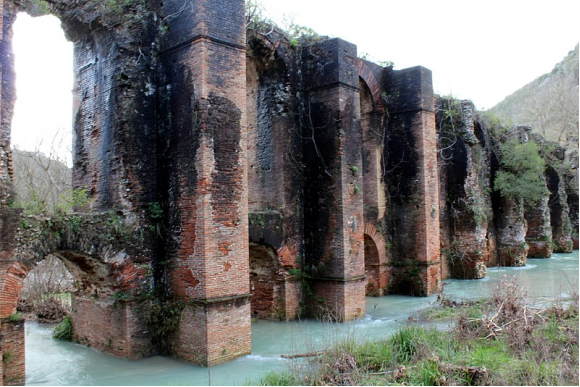
The Roman aqueduct of Nicopolis
VI.History
Antiquity
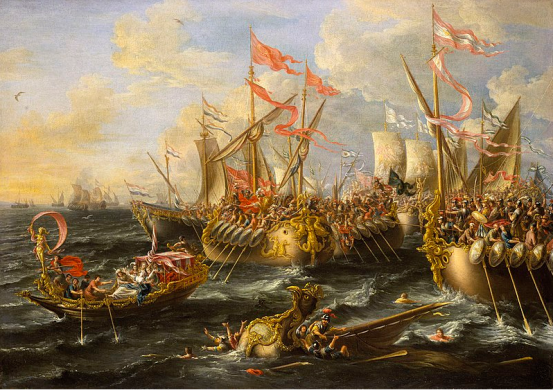
The Battle of Actium, by Laureys a Castro (1672); oil painting in National Maritime Museum of Greenwich, London (Director's Office)
In antiquity, the south-southwestern part of Epirus was inhabited by the Greek tribe of Cassopeans, part of a larger tribe, the Thesprotians. Their capital city was Cassope (today, near the village of Kamarina). At the southernmost part of Epirus, king Pyrrhus founded, in 290 BC, the town of Berenikea or Berenike, named after his mother-in-law Berenice I of Egypt., Today, it is believed that Berenikea lies on the hills near the village of Michalitsi, following the excavations by Sotirios Dakaris in 1965. The Ionian Sea, near Berenikea, was the site of the naval Battle of Actium, on 2 September 31 BC, in which Octavian's forces defeated those of Mark Antony and queen Cleopatra of Egypt. The ancient city of Nicopolis (Νικόπολις, "Victory City") was built, nearby, by Augustus to commemorate his victory. The city is believed to have, at its peak, a population of 150,000. In AD 90, Epictetus arrived at Nicopolis, after he had been banished by the Roman emperor Domitian, and established a school of philosophy. One of his students, Arrian, became a famous historian and recorded all of his works.
Medieval period
The city was first attested in the Chronicle of the Morea (1292). However, Hammond places the foundation of Preveza much later, at the end of the 14th century, possibly by Albanians. After 1204, it came under the Despotate of Epirus. It then came under Venetian rule until it was captured by the Ottomans in 1463.
First Ottoman period
The Ottomans refounded Preveza probably in 1477, with a subsequent strengthening of the fortifications in 1495.[15] The naval Battle of Preveza was fought off the shores of Preveza on 29 September 1538, where the Ottoman fleet of Hayreddin Barbarossa defeated a united Christian fleet under the Genoese captain Andrea Doria. This day is a Turkish Navy National Holiday, and some of today Turkish submarines called "Preveze".
Venetian intervention
See also: Stato da Màr
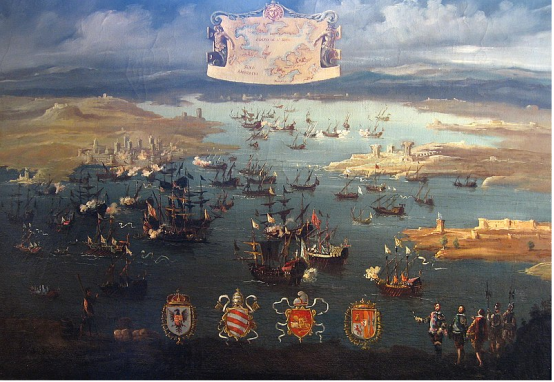
The conquest of Preveza by unknown painter (17th century)
Preveza was hotly contested in several Ottoman-Venetian Wars. In September 1684, at the early part of the Morean War, the Venetians, aided by Greek irregulars, crossed from the island of Lefkada (Santa Maura) and captured Preveza as well as Vonitsa, which gave them control of Acarnania – an important morale booster towards the main campaign in the Morea. However, at the end of the war in 1699 Preveza was handed back to Ottoman rule. Venice captured Preveza again in 1717, during its next war with the Ottomans and was this time able to hold on to the town and fort it – a meager achievement in a war which otherwise went very badly for the Republic. Venetian rule would persist until the very end of the Venetian Republic itself in 1797. During this period, in 1779, the Orthodox missionary Kosmas visited Preveza where it is said he founded a Greek school, which would be the only school of the city during the 18th century. At the end of the 18th century, Preveza became a transit center of trade with western Europe (particularly France), which resulted in the increase of its population to approximately 10,000–12,000.
Year of French rule (1797)
See also: French Revolutionary Wars
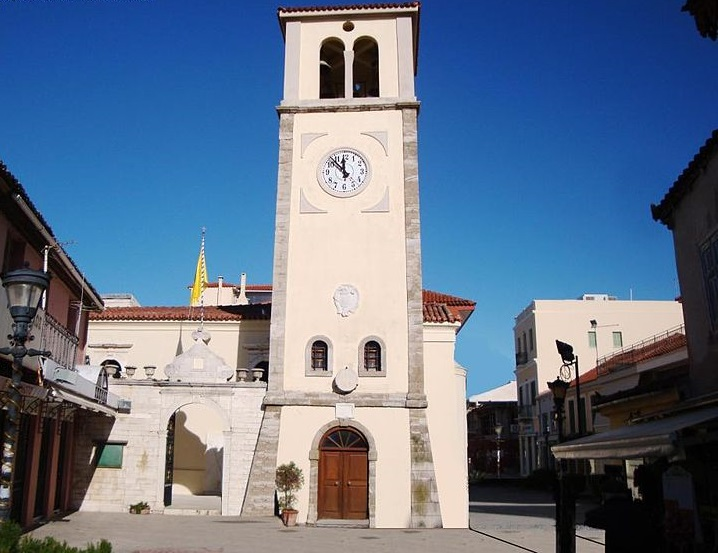
The Venetian clock tower of the city
Battle of Nicopolis
Following the Treaty of Campo Formio, where Napoleon Bonaparte decreed the final dissolution of the Venetian Republic, Preveza – like other Venetian possessions in Greece and Albania – was ceded to Revolutionary France. 280 French grenadiers arrived in Preveza under the commands of General La Salchette. The people of Preveza welcomed the French troops, and formed a pro-French civic militia. Around this same time the poet Rigas Feraios was combining support for the ideas of the French Revolution with calls for a Greek uprising against Ottoman rule. He was intercepted and killed by the Ottoman authorities when en route to meet Napoleon and directly ask for his help for the Greek cause.
Napoleon Bonaparte, however, focused his attention in another direction, launching the French Campaign in Egypt and Syria, placing France at war with the Ottoman Empire and giving little thought to the fate of the small Preveza garrison exposed on the edge of Ottoman territory. In October 1798, the local Ottoman governor Ali Pasha Tepelena – having great ambitions to make himself a semi-independent ruler – attacked Preveza with an overwhelming force. In the Battle of Nicopolis on 12 October 1798 the 7,000 Ottoman troops of Ali Pasha and his son Mukhtar completely overwhelmed the 280 French grenadiers and their local allies, the 200 Preveza Civil Guards and 60 Souliote warriors under Captain Christakis. Over the next two days, 13–14 October 1798, a major massacre of the French troops and the local Greek population which defended the city took place in Preveza and Port Salaora, on the Ambracian Gulf, starting before Ali Pasha entered Preveza on 13 October but also continuing in his presence. On 14 October, Ali Pasha called on those citizens of Preveza who had escaped to the Acarnanian Mountains to return to the city, and declared that they would be in no danger. However, upon their return, 170 of them were executed by the sword at the Salaora Port Customs. Many prisoners who survived the massacre died from the hardships on the road to Ioannina. In the grand return and reception held for his victorious troops, which Ali Pasha organized at Ioannina, surviving French and rebel prisoners were given the unpleasant role of walking at the head of the procession, holding the cut and salted heads of their companions, under the shouts and jeers of Ioannina's pro-Ottoman residents. From Ioannina, nine captured French grenadiers, and two officers were sent chained to Istanbul for questioning. One of them, Captain Louis-Auguste Camus de Richemont, was later released, possibly mediated by the mother of Napoleon Bonaparte, Maria Letizia Bonaparte, and eventually became a general. Some popularly circulating tales, of doubtful historical authenticity, link this incident with the origins of the Spoonmaker's Diamond, one of the most closely guarded treasures of Istanbul's Topkapı Palace.
"Lieutenant Richemont shakes down an Albanian horseman, during the battle of Nicopolis, in October 1798" by Felician Myrbach
Though Preveza would remain under Ottoman rule for more than a century, this event – both the short period of Greek militias active in the city and the shock of the massacre that followed – and the influence of the ideas of the French Revolution had a part in the development of Greek nationalism towards the Greek War of Independence, which broke out three decades later.
Second Ottoman period
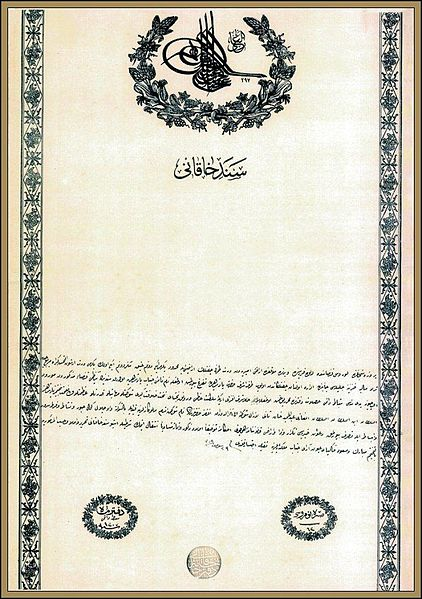
A 1892 decree signed by the Ottoman Sultan Abdul Hamid II which documents possession of a state farm in Preveza passing to the Sultan's ownership
From 1798 to 1820, Preveza was under the rule of the semi-independent Ali Pasha Tepelena. Following his death in 1822 at Ioannina, Preveza was more directly controlled from Istanbul. Preveza became the seat of a province (the Sanjak of Preveze) in 1863, until the year 1912 when the city joined Greece. In 1835, educational activity in the city revived with the foundation of a new Greek school, the Theophaneios, named after its sponsor, Anastassios Theophanis. In the following decades, this school became a centre of education in the surrounding area and in 1851 it also hosted a female and a secondary school.
According to the Congress of Berlin in 1878, parts of southern Epirus, including Preveza, were to be ceded by the Ottoman Empire to the Kingdom of Greece. Under this context, five meetings were held in Preveza, between Greek and Ottoman representatives, but all of them failed to reach an agreement. Even before negotiations started, the Ottoman side used a number of Albanian national figures for delaying purposes and appointed Abedin bey Dino, member of the League of Prizren and representative of the Albanian national movement, as Ottoman foreign minister. Moreover, Abedin Dino managed to gather various Albanian personalities in Preveza, from all over Albania and Epirus, who believed that the Ottomans will provide full support to the Albanian movement and were against annexation of Epirus to Greece. They also organized a meeting there in January 1879 and on 28 February 1879, signed a petition with a threat to take arms to prevent an annexation of Preveza to Greece. As a result of the unrest created, led by Abdyl Frashëri, another Albanian national figure, the local Ottoman governor was recalled. Abedin Dino was also recalled from Preveza, while the recently arrived Albanians left the city and returned to their homelands.
The discussions between the two sides continued later in Constantinople, but the Ottoman side disagreed with the proposed border by using as an excuse the unrest created by Albanian representatives.In March 1881, the Ottoman side proposed the cession of Thessaly and Arta regions, a proposal that ignored the Albanian positions, and was finally accepted by Greece, although most of Epirus was still outside Greece. On the other hand, the Greek organisation, Epirote Society, founded in 1906 by members of the Epirote diaspora, Panagiotis Danglis and Spyros Spyromilios, aimed at the annexation of the region to Greece by supplying local Greeks with firearms.
From 1881 to 1912 the main sectors of the local economy witnessed dramatic decline and the port of the city lost most of its former commercial significance. However, education was still flourishing with two schools operating: one boys' and one girls' school. The school system of the city was primarily financed by Anastasios Theofanis, notable member of the diaspora.
Annexation to Kingdom of Greece
The city of Preveza remained under Ottoman control until finally taken by the Greek Army on 21 October 1912, during the First Balkan War. The city was liberated after the Battle of Nicopolis, by the Greek forces under Colonel Papagiotis Spiliadis. A garrison of the 8th Infantry Division was stationed in the city by December. Later on in the same war, on 8 February 1913, the inhabitants of Preveza were involved in the first instance in world history of a pilot being shot down in combat. The Russian pilot N. de Sackoff, flying for the Greeks, had his biplane hit by ground fire following a bomb run on the walls of Fort Bizani near Ioannina. He came down near Preveza, and with the help of local townspeople repaired his plane and resumed his flight back to base. In the following months there arrived in Preveza the famous Swiss photographer Frederic Boissonnas, and a lot of photographs from this period are available today. Preveza along with the rest of southern Epirus formally became part of Greece via the Treaty of London in 1913.
After the Balkan Wars the harbor of Preveza became a significant regional commercial center in western Greece. Moreover, local labor unions were created during the Interwar period.
Second World War
Along with the rest of Greece, Preveza was occupied by Fascist Italy (1941–1943) and Nazi Germany (1943–1944) during World War II. After the departure of the Wehrmacht from Preveza, in September 1944, an episode of the Greek Civil War known as the Battle of Preveza took place, lasting for 16 days, between armed partisans of the right-wing EDES and the left-wing EAM-ELAS. The fights stopped after the Convention of Cazerta between Great Britain and the two main Greek resistance groups, EDES and ELAS.
Modern period
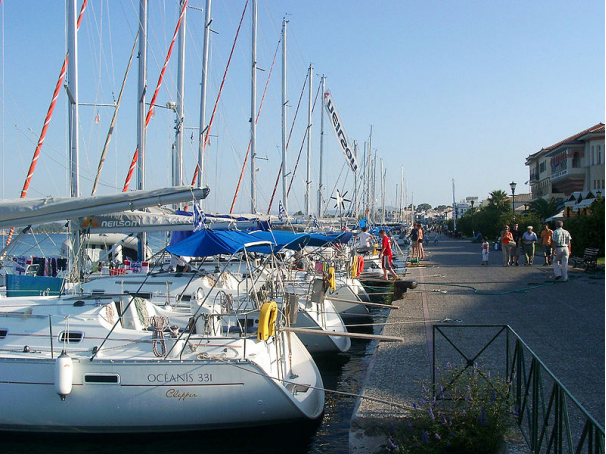
View of the promenade
Today Preveza is a commercial harbor and tourist hub, with a marina, 4 Museums, two cinemas, an open theatre, a music Hall (OASIS), many clubs, taverns, and cafes, benefiting from its proximity to the nearby Aktion National Airport and the nearby island of Lefkada, a major tourist destination. There are in the city the University department of Financial (department of university of Ioannina) and Commercial Navy Academy. The Aktio-Preveza Immersed Tunnel, opened on 2002, is an important work of infrastructure for what has traditionally been a remote and underdeveloped region, and links Preveza to Actium (Greek: Άκτιο, Aktio) on the southern shore of the Ambracian Gulf, greatly shortening the distance of the trip to Lefkada.
VII.Other information
Origin of the name
Despite the three views which have been presented by the academic society on the origin of the name "Preveza", the most accepted view is that Preveza means Passage, and that the word reached this form from the Slavic, through the Albanian language.
The first view suggests that the name "Preveza" originates from the Slavic word prěvozъ, meaning passage. This view is adopted mainly by: Max Vasmer, Diogenis Chariton, Fyodor Uspensky, Ioannis Demaratos, Peter Soustal & Johannes Koder, Alexios G. Savvides, Elias Vasilas, Nikos D. Karabelas, Demosthenis A. Donos, and others.
The second view suggests that the name originates from the old Albanian word prevëzë -za, which means passage, transition, crossing over. This view is adopted mainly by: Petros Fourikis, Konstantinos Amantos, Max Vasmer, Peter Soustal & Johannes Koder, Alexis G.K. Savvides, Nikos D. Karableas, Demosthenis A. Donos, and others.
The third view suggests that the word originates from the Italian word prevesione, which means provision, supply. This view was mainly adopted by Panagiotis Aravantinos.
VIII.Contact information

Mayor Nikolaos Georgakos
Municipality of Preveza
Address: El. Venizelou 24, 481 00
Phone: +30 2682 360600
Url: http://www.dimosprevezas.gr
Reference: https://www.visit-preveza.com/el/municipa
